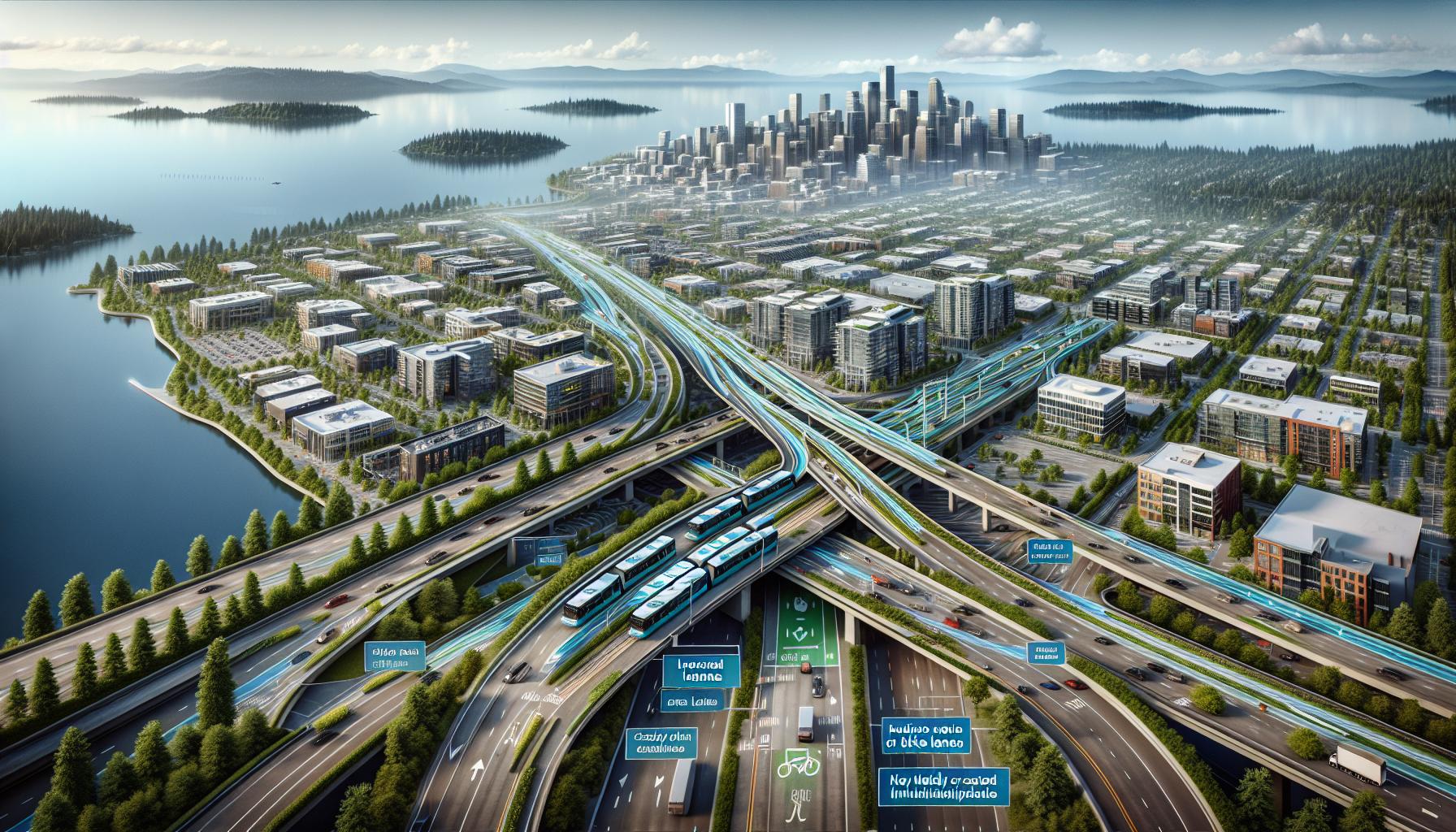Buckle up, folks, as we’re about to embark on a thrilling journey through Kirkland’s transportation revolution. This picturesque city, nestled on the shores of Lake Washington, has been making some serious waves in the realm of transport. And I’m not just talking about its pristine ferry routes!
From innovative bike lanes to state-of-the-art public transit, Kirkland’s been blazing a trail for other cities to follow. It’s a fascinating story of how a city can transform its transportation infrastructure, enhancing the quality of life for its residents while setting an example for sustainable urban development. So, let’s dive in and explore the roads to success that have put Kirkland on the map as a beacon of transportation innovation.
Overview of Kirkland’s Transportation Revolution: Roads to Success
Diving into the depths of Kirkland’s transportation revolution reveals a town that’s actively reshaping its mobility landscape. Progressing through this maze, we notice changes that have positively impacted the quality of life and fostered sustainable urban growth.
Key Features of Kirkland’s Transportation Transformation
Key highlights of this transformation encompass strategic planning, expanded use of public transport, and biking facilities. Kirkland’s smart planning model, for example, emphasizes efficient use of existing infrastructure and focuses on projects with significant impact. Public transportation leaps forward, with increased bus frequencies and dedicated bus lanes easing commute times. The city’s newly implemented bike lanes and multi-modal paths provide safe navigation, doubling as steps towards reducing pollution by encouraging active travel.
Exploring the Past and Present Transport Infrastructure in Kirkland
Observing Kirkland’s transport heritage presents a narrative of smart evolution and adaptation. Back in its early years, Kirkland was a lakefront community largely dependent on water transportation. Evolution commenced with the transition to reliance on highways and automobiles, culminating in the 1970s Interstate 405 development. In the present time, Kirkland’s transportation ecosystem brims with diversity, integrating public buses, cycling lanes, pedestrian-friendly paths, and shared mobility platforms. This blend of past practices and present innovation reveals an achieved balance – an example of progression without ignoring heritage.
Evaluating Kirkland’s Road-Upgradation Projects
Let’s delve deeper to assess the transformative projects that have propelled Kirkland’s road-upgradation efforts.
How Kirkland’s Road Infrastructure Has Evolved Over the Years
Looking back, Kirkland’s journey reveals a consistent evolution in road infrastructure. In its early days, the city’s structure was predominantly influenced by water transport. A focus on maritime-driven design defined its roadways, which were aimed at supporting transit towards the water bodies.
Over the years, changes in lifestyle, industry, and technology triggered demand for diverse modes of transport. As the use of automobiles increased during the 20th century, Kirkland revamped its transportation map and progressively shifted its infrastructure focus. The city has since witnessed a transformation from being water-transport dominant to establishing a diverse and comprehensive transportation infrastructure.
New Developments and Improvements in Road Transportation
Kirkland’s more recent road transportation improvements showcase the city’s commitment to facilitate efficient, accessible, and sustainable transport. The city has widened and repaired main arteries, established express bus lanes, and incorporated intelligent transportation systems for monitoring traffic and controlling signals.
Moreover, new bike lanes and multi-modal paths have been introduced to promote safe and active travel, helping to mitigate pollution. In a noteworthy move towards sustainable travel, the city has also prioritized the integration of shared mobility platforms. This promotes a collective use of transportation services, reducing the number of vehicles on the road and contributing to a cleaner and greener Kirkland.
Benefits and Challenges of Kirkland’s Transportation Revolution
Delving deeper into the transportation revolution, I’m thrilled to analyze the economic, environmental, and social advantages, along with the challenges that such significant changes pose.
Economic Impacts of Improved Transportation Infrastructure
Considerably, Kirkland’s upgraded transportation system contributes to significant economic growth. Enhanced traffic flow, amplified through separate bus lanes coupled with increased frequencies, reduces travel times, boosting productivity and promoting economic development. The provision of shared mobility platforms and intelligent traffic management systems presents new opportunities for start-ups and tech-based companies. As an example, ride-sharing applications present a new business model, leading to job creation and fostering innovation. Complementing these are the bike lanes and multi-modal pathways. With the installation of these, commuting becomes cheaper for the residents, amounting to substantial savings on fuel costs. Nevertheless, the substantial investments needed for implementing such vast transportation initiatives presents a financial challenge. The recurring costs of maintenance and upgradation also remain constant hurdles.
Environmental and Societal Implications of Roadway Overhauls
Transitioning to more sustainable modes of transportation, such as bikes, paves the path towards a green and clean Kirkland. The reduction in dependency on private vehicles, propelled by the provision of resilient public transport and shared mobility platforms, directly contribute to lower CO2 emissions and cleaner air quality. This brings us to the societal implications. Users — from students to working professionals — find their commutes streamlined. Dedicated bike lanes and pedestrian-friendly pathways significantly reduce accident rates, ensuring a safer community for the residents. Indirectly, multi-modal commuting stimulates a healthier lifestyle, therefore fostering community wellbeing. Despite the benefits, it’s pertinent to recognize the hurdles such as public acceptance of the new systems and the transition phase which might pose some temporary inconveniences. However, with a carefully calibrated approach, Kirkland navigates towards the goal of a sustainable and inclusive transportation revolution.
Stakeholders in Kirkland’s Transportation Revolution
In understanding Kirkland’s transportation evolution, importance lies in acknowledging all key players. Their collective commitment and cooperation contribute to the city’s remarkable progress.
Government’s Role in Facilitating Infrastructure Upgrades
As an integral stakeholder, the government’s influence is most apparent in infrastructure upgrades. They’re the driving force behind Kirkland’s transportation transformation. Resources are strategically invested, targeting key areas such as road maintenance, extension of cycling lanes, and integration of smart traffic management systems.
Public transport sees a significant shift, notably in increased bus frequency and dedicated routes. The government’s deliberate move to streamline commutes, reduce congestion, and make the city more accessible creates an efficient and resilient transportation landscape.
Smart infrastructure is another investment avenue. Traffic systems that incorporate artificial intelligence for real-time updates and adjustments push Kirkland further into the future of urban transportation. It’s a testament to the government’s dedication to fostering a well-connected, sustainable city.
Local Businesses and Residents’ Reaction to The Changes
Local businesses and residents also play crucial roles in Kirkland’s transportation revolution. In response to the changes, there’s been a largely positive reception from these groups. Local businesses see improved accessibility as an opportunity for growth. A more efficient transportation network means more customers can reach them, reflecting in business expansion and profit increases.
Residents, on the other hand, benefit from shortened commute times and better living environments. Expanded biking facilities and pedestrian-friendly paths enhance mobility, catering particularly to the active and health-conscious. The commitment to lower CO2 emissions creates cleaner surroundings, improving air quality and promoting overall wellbeing.
It’s critical to note that change isn’t without its challenges. While the upgrades bring substantial benefits, the transition period demands patience and flexibility. Yet most agree that navigating through these challenges is worth the perks of improved infrastructure and a greener, healthier Kirkland.
Comparative Analysis of Kirkland with Other Cities
Delving into a comparative study heightens the understanding of Kirkland’s profound advancement in transportation innovation. In this context, let us align Kirkland’s successful initiatives with other cities and determine the learnings that can be shared.
Benchmarking Kirkland’s Transportation Improvements
In our study, we find that Kirkland’s transformation outshines many metropolitan areas. For instance, its amplification of public transit, validated by increased bus frequencies, feature higher when compared to neighboring cities. A quintessential example is Bellevue, where public transit patterns fail to match Kirkland’s efficiency. It’s Kirkland’s foresight in smart planning, which emphasizes the effective use of infrastructure, that facilitates faster commutes.
Additionally, comparing Kirkland’s cycling infrastructure reveals a vision surpassing that of its contemporaries. The introduction of bike lanes and multimodal paths offer residents safe travel options, effectively curtailing air pollution—this contrasts with the slower progression towards cycle-friendly infrastructure in cities like Redmond. The city’s extraordinary strides fall in sync with its commitment to sustainability and the betterment of resident lifestyles.
Exploring How Other Cities Can Learn from Kirkland’s Experience
In the broader scope, Kirkland’s transportation blueprint serves as a beacon for other cities across the nation. Cities looking to optimize their transportation systems can draw on Kirkland’s integrated approach, including strategic planning, expansion of public transport, and fortification of biking facilities.
For instance, the integration of intelligent transportation systems, another feather in Kirkland’s cap, could be imitated by cities facing traffic management issues. Similarly, cities grappling with sustainability goals might consider adopting Kirkland’s emphasis on shared mobility platforms, which effectively curtail vehicle numbers.
Kirkland isn’t just leading—it’s teaching other cities that innovation coupled with local needs and sustainable practices can fundamentally transform urban transportation landscapes. With patience and a strong vision, it’s possible to navigate towards a more efficient, inclusive and progressive future. It’s this forward-looking and holistic approach that sets Kirkland’s transportation revolution as a model worth emulating.
Future Outlook of Transportation in Kirkland
As I move towards future prospects, it’s in shedding light upon the trends and challenges in Kirkland’s transportation landscape that I provide promising insights.
Predicted Trends and Innovations in Kirkland’s Transportation Sector
One trend to behold is the integration of advanced technologies. Kirkland plans to harness technology such as intelligent traffic systems—systems equipped with smart sensors to oversee traffic movements, for instance. Furthermore, autonomous vehicles, particularly self-driving buses, fall into the city’s radar. More than 50% of states have already passed laws for autonomous vehicles; Kirkland expects to follow suit, according to the National Conference of State Legislatures.
Demonstrating a commitment to sustainability, the city anticipates more electric vehicles, bikes, and interconnected metro lines. Additionally, shared mobility platforms, which presently cater to 36% of the city’s residents, as per the King County Metro report, are primed to expand.
Anticipated Challenges and Solutions For Future Development
Each innovation, however, brings its own set of challenges. The primary issue is funding the advanced technologies, considering that current traffic management systems are expected to cost billions of dollars. Governmental help, from local to federal, is essential for Kirkland’s progress, with strategies like private-public partnerships being a viable solution.
Acceptance of new technologies is also a potential challenge. The encouragement and education of residents about the benefits and usage of autonomous vehicles and shared mobility platforms is crucial. To address this, city officials can organize awareness camps and roadshows, illustrating the effectiveness of these advancements.
Lastly, maintaining a balance between expanding shared mobility platforms and preserving public transportation might prove intricate. Ensuring both modalities are adequately funded and accessible offers an effective solution. Collectively, these challenges and solutions form the blueprint for Kirkland’s future transportation development.
Conclusion
Kirkland’s transportation revolution has truly been a journey worth admiring. It’s a testament to the city’s commitment to sustainable development and quality of life. From strategic planning to smart traffic management, Kirkland’s approach has been comprehensive and forward-thinking. Despite challenges, the city’s continued focus on integrating advanced technologies and promoting shared mobility platforms is inspiring.
What’s particularly striking is how Kirkland has managed to balance progress with respect for its transport heritage. It’s not just about building the future, but also about honoring the past. And the city’s success in this regard offers valuable insights for other cities on a similar path.
As we look ahead, it’s clear that Kirkland’s journey isn’t over. There’s more to come, and I’m excited to see where this road leads. It’s a ride we can all learn from, and I can’t wait to see what’s next on the horizon for this innovative city.





0 Comments